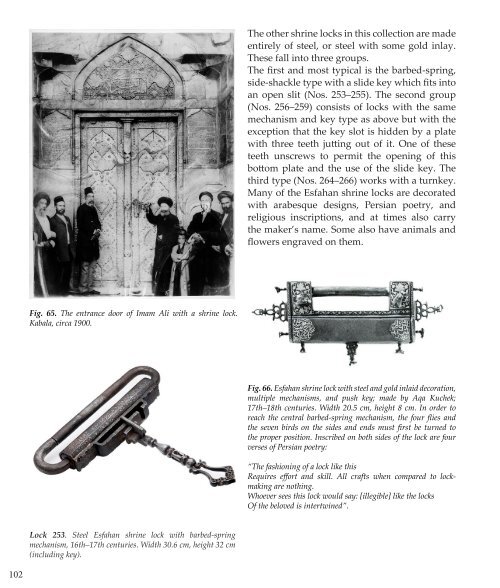Persian Locks: 1500 Years of Iranian Padlocks
In Iran, the padlock was developed in an amazing variety of sizes, shapes, materials, and mechanisms, the likes of which are less frequently encountered in Europe. On the whole, very little attention has been devoted to the history and development of the lock in Iran. Parviz Tanavoli, Iran's leading sculptor, was first attracted to the locks of his own country because of their sculptural qualities. In this beautiful and informative book the author shares with us, in over 500 photos and drawings, the most interesting examples of locks from his famous collection which was first introduced to the American public by the Smithsonian Institute on the occasion of the American Bicentennial. You will also find detailed drawings which clearly illustrate the workings of the various locking mechanisms (e.g., barbed-spring, helical-spring, notched-shackle, hook and revolving catch, etc.) used in the locks in this book. All locks are dated and when known, the place of manufacture is given. A smaller version of this updated and expanded book was published by The Smithsonian Institution in 1976 with the title, "Locks from Iran: Pre-Islamic to Twentieth Century." In 2019 and 2020 the author edited his original book adding new text and a great number of new high-quality photos of locks which have been added to his collection in the 44 years since the first book was published. Hardcover, 144 pages, 10-inches x 8.5-inches, over 500 photos and drawings.
In Iran, the padlock was developed in an amazing variety of sizes, shapes, materials, and mechanisms, the likes of which are less frequently encountered in Europe. On the whole, very little attention has been devoted to the history and development of the lock in Iran.
Parviz Tanavoli, Iran's leading sculptor, was first attracted to the locks of his own country because of their sculptural qualities. In this beautiful and informative book the author shares with us, in over 500 photos and drawings, the most interesting examples of locks from his famous collection which was first introduced to the American public by the Smithsonian Institute on the occasion of the American Bicentennial. You will also find detailed drawings which clearly illustrate the workings of the various locking mechanisms (e.g., barbed-spring, helical-spring, notched-shackle, hook and revolving catch, etc.) used in the locks in this book. All locks are dated and when known, the place of manufacture is given.
A smaller version of this updated and expanded book was published by The Smithsonian Institution in 1976 with the title, "Locks from Iran: Pre-Islamic to Twentieth Century." In 2019 and 2020 the author edited his original book adding new text and a great number of new high-quality photos of locks which have been added to his collection in the 44 years since the first book was published.
Hardcover, 144 pages, 10-inches x 8.5-inches, over 500 photos and drawings.
Create successful ePaper yourself
Turn your PDF publications into a flip-book with our unique Google optimized e-Paper software.
The other shrine locks in this collection are made<br />
entirely <strong>of</strong> steel, or steel with some gold inlay.<br />
These fall into three groups.<br />
The first and most typical is the barbed-spring,<br />
side-shackle type with a slide key which fits into<br />
an open slit (Nos. 253–255). The second group<br />
(Nos. 256–259) consists <strong>of</strong> locks with the same<br />
mechanism and key type as above but with the<br />
exception that the key slot is hidden by a plate<br />
with three teeth jutting out <strong>of</strong> it. One <strong>of</strong> these<br />
teeth unscrews to permit the opening <strong>of</strong> this<br />
bottom plate and the use <strong>of</strong> the slide key. The<br />
third type (Nos. 264–266) works with a turnkey.<br />
Many <strong>of</strong> the Esfahan shrine locks are decorated<br />
with arabesque designs, <strong>Persian</strong> poetry, and<br />
religious inscriptions, and at times also carry<br />
the maker’s name. Some also have animals and<br />
flowers engraved on them.<br />
Fig. 65. The entrance door <strong>of</strong> Imam Ali with a shrine lock.<br />
Kabala, circa 1900.<br />
Fig. 66. Esfahan shrine lock with steel and gold inlaid decoration,<br />
multiple mechanisms, and push key; made by Aqa Kuchek;<br />
17th–18th centuries. Width 20.5 cm, height 8 cm. In order to<br />
reach the central barbed-spring mechanism, the four flies and<br />
the seven birds on the sides and ends must first be turned to<br />
the proper position. Inscribed on both sides <strong>of</strong> the lock are four<br />
verses <strong>of</strong> <strong>Persian</strong> poetry:<br />
“The fashioning <strong>of</strong> a lock like this<br />
Requires effort and skill. All crafts when compared to lockmaking<br />
are nothing.<br />
Whoever sees this lock would say: [illegible] like the locks<br />
Of the beloved is intertwined”.<br />
Lock 253. Steel Esfahan shrine lock with barbed-spring<br />
mechanism, 16th–17th centuries. Width 30.6 cm, height 32 cm<br />
(including key).<br />
102










